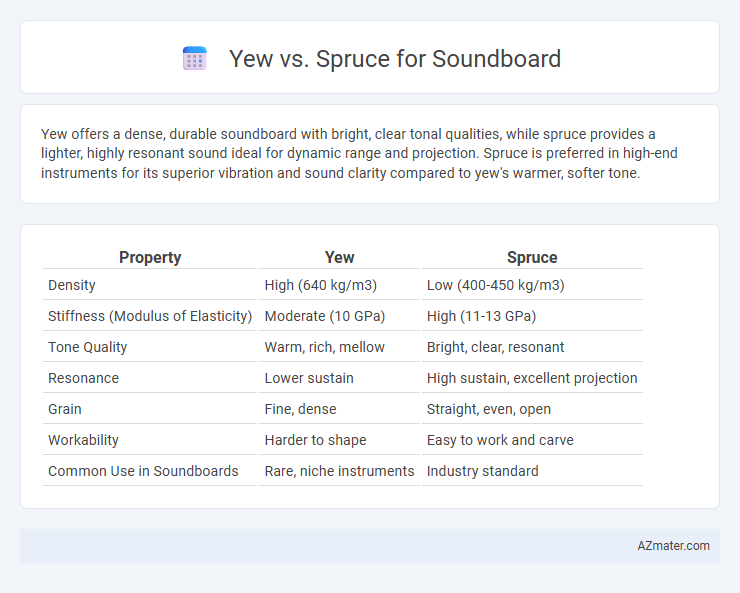Yew offers a dense, durable soundboard with bright, clear tonal qualities, while spruce provides a lighter, highly resonant sound ideal for dynamic range and projection. Spruce is preferred in high-end instruments for its superior vibration and sound clarity compared to yew's warmer, softer tone.
Table of Comparison
| Property | Yew | Spruce |
|---|---|---|
| Density | High (640 kg/m3) | Low (400-450 kg/m3) |
| Stiffness (Modulus of Elasticity) | Moderate (10 GPa) | High (11-13 GPa) |
| Tone Quality | Warm, rich, mellow | Bright, clear, resonant |
| Resonance | Lower sustain | High sustain, excellent projection |
| Grain | Fine, dense | Straight, even, open |
| Workability | Harder to shape | Easy to work and carve |
| Common Use in Soundboards | Rare, niche instruments | Industry standard |
Introduction: Yew vs Spruce for Soundboards
Yew and spruce are two notable tonewoods commonly used in soundboard construction, each influencing acoustic properties differently. Spruce, particularly Sitka or Engelmann varieties, is prized for its lightweight, strength-to-weight ratio, and bright, clear tonal qualities, making it a traditional choice for many high-performance instruments such as violins, guitars, and pianos. Yew, less common but valued for its dense grain and warm, rich sound, offers greater durability and a unique tonal depth, providing an alternative for luthiers seeking distinct resonance and aesthetic qualities.
Historical Use of Yew and Spruce in Instrument Making
Yew and spruce have played significant roles in the historical construction of soundboards for stringed instruments, with spruce predominantly favored for its superior stiffness-to-weight ratio and resonant qualities, which enhance tonal clarity and projection. Historically, yew was occasionally used in early European instruments, prized for its density and warm tonal characteristics, yet its heavier weight and less consistent grain made it less ideal compared to spruce's consistent acoustic properties. Modern luthiers often select spruce species such as Sitka, Engelmann, or Adirondack spruce for soundboards due to their proven record in delivering strong, bright, and responsive sound, while yew's use remains more niche and primarily linked to traditional or bespoke craftsmanship.
Acoustic Properties: Yew Compared to Spruce
Yew wood exhibits a dense and stiff fiber structure that provides a warm, rich tonal quality with excellent sustain, making it a unique choice for soundboards compared to the traditionally favored spruce. Spruce is renowned for its high strength-to-weight ratio and consistent grain, producing bright, clear, and resonant sounds with a wide dynamic range that suits various musical styles. While spruce offers superior projection and responsiveness, yew's natural damping characteristics yield a mellower tone with enhanced midrange warmth, appealing to players seeking a distinctive acoustic character.
Tone Quality Differences: Warmth, Clarity, and Projection
Yew soundboards offer a unique combination of warmth and clarity, producing a rich, resonant tone with deep midrange frequencies that enhance musical expression. Spruce soundboards excel in bright projection and clarity, providing a clear, articulate sound with strong high-frequency response suitable for detailed tonal nuances. The choice between yew and spruce impacts the instrument's voice, with yew delivering warmer, fuller tones while spruce emphasizes vibrancy and precise note definition.
Durability and Structural Stability
Yew offers exceptional durability and structural stability for soundboards due to its dense grain and natural resistance to warping, making it a reliable choice in varying humidity conditions. Spruce, known for its lightweight strength and consistent elasticity, provides superior resonance but requires more careful maintenance to prevent structural issues over time. Both woods deliver excellent tonal qualities, but Yew's robustness makes it preferable for long-term stability in instrument construction.
Availability and Sustainability of Yew and Spruce
Spruce is widely available and sustainably harvested, making it the preferred choice for soundboards in instrument manufacturing due to its consistent grain and tonal properties. Yew, by contrast, is less abundant and often sourced from protected or limited areas, raising concerns about its sustainability and long-term availability for commercial use. Choosing spruce supports sustainable forestry practices, while yew may require careful management to avoid environmental impact.
Workability: Luthier Preferences in Craftsmanship
Yew is favored by luthiers for soundboards due to its exceptional workability, allowing precise carving and fine detailing that enhances acoustic properties. Spruce, while slightly harder to work with, remains popular for its consistent grain and superior strength-to-weight ratio, offering durability alongside excellent resonance. Craftsmanship preference often hinges on the balance between ease of shaping in Yew and the proven tonal reliability of Spruce.
Cost Analysis: Yew versus Spruce Soundboards
Yew soundboards typically cost 20-30% more than spruce due to their limited availability and slower growth rate, impacting overall production expenses. Spruce remains the preferred choice for soundboards in musical instruments because of its favorable strength-to-weight ratio and widespread availability, resulting in lower material costs. While yew offers unique tonal qualities, the higher raw material and processing costs often make spruce the more cost-effective option for manufacturers balancing quality with budget.
Common Instruments Using Yew or Spruce Soundboards
Spruce is the most popular choice for soundboards in common instruments like acoustic guitars, violins, and pianos due to its lightweight strength and excellent resonance, producing clear, bright tones. Yew, while less common, is sometimes used in specialized instruments or high-end custom builds, prized for its unique tonal warmth and sustained resonance. Both woods contribute distinct acoustic qualities, with spruce offering more projection and yew emphasizing rich midrange frequencies.
Choosing the Right Wood for Your Soundboard
Yew and spruce are popular choices for soundboards due to their distinct tonal qualities and workability. Spruce is favored for its lightness, stiffness, and superior resonance, providing a bright, clear sound ideal for guitars and violins. Yew, though less common, offers a warm, rich tone with excellent sustain, making it suitable for specialized or traditional instruments seeking a unique acoustic character.

Infographic: Yew vs Spruce for Soundboard
 azmater.com
azmater.com